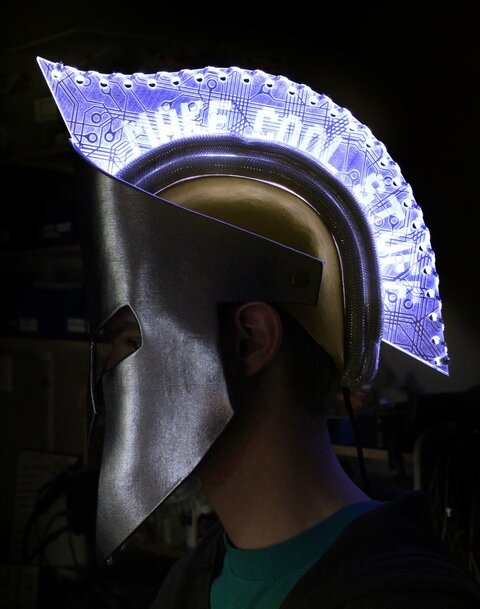More updates in Wearable technology land.
New project: Calgary Comic Expo - Make something cool
Solution:
Spartan Helmet with
Laser etched acrylic plume and underlit with LEDS
Fosshape
base molded to my head with another U-shaped
channel for LEDs and acrlyic to sit in. Take Cardboard
template to my head to get the curve right, as well as allow proper clearance for LEDs underneath. Scan cardboard
template into Corel Draw and convert to a vector
image. Choose and draw patterns in a vector format. I used three layers of acrylic to get a more complex
image. One layer of "
circuit board", one layer of "Make Cool Stuff" text, last layer of the negative space of the "
circuit board"
pattern. Before peeling the protective paper off of the acrylic after lasering, I shot the Text layer with White Spray Paint to make it more readable and interesting when powered off. Installed the LEDs by soldering them into a curved shape in parallel and wired down to a battery pack on my waist. Covered in pretty fabric and voila.
Challenges:
While a very small project, I learned quite a
bit about using
laser etched and cut materials. The problem with people is that they are 3D, while the acrylic starts out life as 2D. As with electronics, this need to take materials that are meant to be
flat and conform them to an irregularly shaped body (that flexes and moves and wrecks havoc on wiring) can prove to be interesting. While I didn't
bend acrylic this time, it will be interesting to see how it can be utilized in the future to create 3D shapes. Another challenge is mating hard materials with soft fabrics and differing techniques available to each method. The shop I was working with suggested T-nut construction, bolts, and screws, while the costumer suggested zip ties, glue and thread. Rather than any hard and fast rule, it is more of a case by case basis for attachment.
Conclusion: A good
introduction to using
laser etched material for costuming. Next year might just need to be a suit of armor to match.



